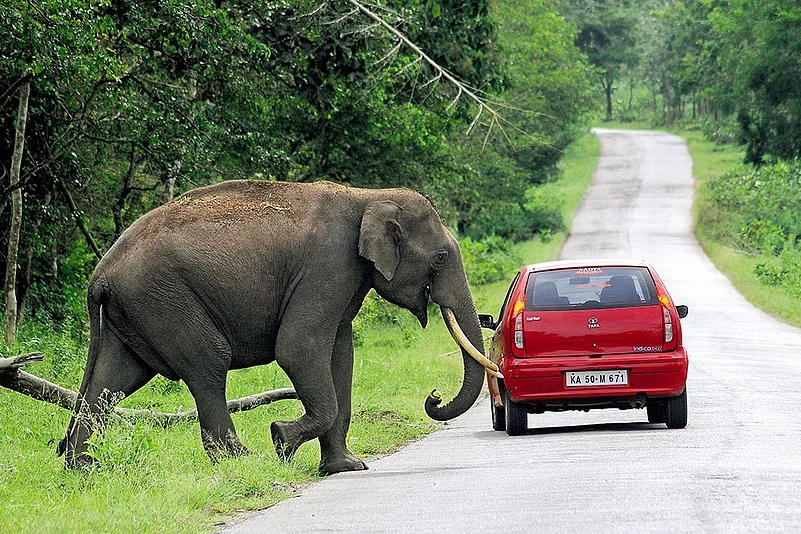A ban on night-time traffic has been in force for ten years in Bandipur National Park through whose critical tiger habitat two national highways pass—it has been contested, of course, all these years through litigation. Now, however, bordering Wayanad has risen in protest. Demonstrations and indefinite fasts have marked the past couple of weeks in the hilly Kerala district into which Rahul Gandhi, as its MP, has waded in.
The protests in Wayanad cut across ruling and opposition party lines and have taken on an emotive colour with wide coverage in Kerala’s media outlets. A hunger strike, which began on September 25, was called off last weekend after the state government promised the protestors of all support to resolve the issue. But the matter is being heard in the Supreme Court since 2010 and the Kerala government a party to the litigation all along.
Locals groups want the night ban on National Highway 766 lifted, citing hardships to livelihood such as transporting vegetables and essentials between Sulthan Bathery and Mysore. “There are several issues here and the aim of the demonstrations is to draw national attention to them,” I.C. Balakrishnan, Sulthan Bathery MLA, tells Outlook. The protests come in the wake of the apex court’s August 7 directive that the night-ban would stay. The court asked the environment ministry to come up with suggestions as to how the alternative route can be upgraded and NH 766 may then, in the long run, be closed down.
“Closing the road entirely will lead to a difficult situation. We need to consider ideas like building flyovers and there’s need for talks between Kerala and Karnataka governments,” says Balakrishnan. There have been discussions over the years and Karnataka has been firm on the traffic restrictions.

The idea of flyovers in Bandipur forest, which forms part of the 5,000 square km Nilgiri Biosphere Reserve that’s home to one of the largest meta-population of tigers and Asiatic elephants in the world, too has been put forth in the long timeline of the issue. But a committee has concluded that the proposal to build five one-km overpasses along the stretch was not feasible. Also, as the court noted, the dispute is only from the Kerala side—all these years there’s been no opposition to the 9 pm to 6 am traffic shutdown on the other road, the Mysore-Ooty national highway passing through Bandipur and Mudumalai national parks, because both Karnataka and Tamil Nadu support the ban.
The tussle over NH 766—and the suggestion of a separate road—goes back to 2009 when district authorities in Karnataka enforced the night ban citing an alarming number of road kills because of speeding traffic. Back then, forest officials had recorded that on average there were 30 vehicles per hour on the two national highways between 8 pm and 6 am. The ban was withdrawn soon after when objections came from Kerala. It led to a lawsuit and the Karnataka High Court ruled in March 2010 that the nightly restriction be enforced. Since then, the appeal challenging that judgment is in the apex court.
Even now a restricted number of transport buses from either state have permission to ply at night as do emergency vehicles. The alternative road—Mananthavady-Kutta-Gonikoppal-Mysore—passing through a buffer zone of the forests is an all-night stretch and longer by about 35 km.
Forest officials in Karnataka say the traffic restrictions in Bandipur over the past 10 years have eased the pressure on wildlife significantly. The other reserve forests in Karnataka having night bans include Nagarahole National Park adjoining Bandipur, BR Hills and the Khanapur-Bhimgad-Anmod stretch—of cou-rse, some of these are relatively minor roads which have alternatives. Beyond, the often-cited example of a night-ban is Nagarajuna Sagar-Sris-ailam Tiger Reserve straddling Andhra Pra-desh and Telangana.
Linear intrusions into wildlife habitats have been a recurring theme—take as instances the litigation over Rajaji National Park in Uttarakhand or Pench Tiger Reserve in Maharashtra. Conservationists argue that animal mortalities due to collisions are only one part of the negative impact of highways through forests. The fundamental issue is fragmentation of the habitat.
A few months ago, a video of a tiger in Pench, rated the best managed park in India, clambering over a road divider to cross the national highway drew much attention. The expanded highway is the country’s first to have underpasses for wildlife to cross over and recent reports suggest that camera traps were able to record evidence of animals passing through them. But the stretch has also attracted criticism from conservationists who point out that the initial design recommendations for the underpasses were subsequently whittled down. “They say in the corridors we have made flyovers and underpasses for the animals. But when you see a tiger passing through a road and jumping over a barrier to the other side, the claim is contradicted,” says P.K. Sen, former director of Project Tiger.
The Pench underpasses cropped up during a Lok Sabha question hour in July when Kerala MP Kodikunnil Suresh asked highways minister Nitin Gadkari if the government would consider the idea of elevated corridors in Bandipur. This was before the recent Supreme Court order. Gadkari replied that he wasn’t in a position to accept the suggestion, reasoning that the 9-km stretch in Pench came at a high cost: Rs 1,300 crore. “This is public money. Is it correct or not? It is up to you to decide,” he had said.
Conservationists point out that there are other ways to strike a balance and resolve conflicts, especially when livelihood and trade comes into question. “We also understand the problems faced by farmers,” says Praveen Bhargav of Wildlife First, one of the litigants in the Bandipur case. He points to the government’s policy on setting up cold storage facilities, which could tackle the challenge of perishable goods, if required. “It’s an innovative application of a related solution. One needs to think out of the box so that people are not put to trouble and wildlife gets a breather,” he says.
By Ajay Sukumaran in Bangalore


























